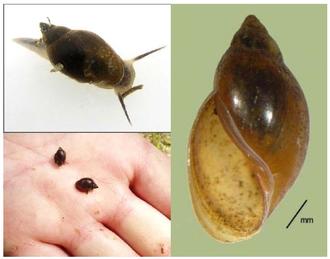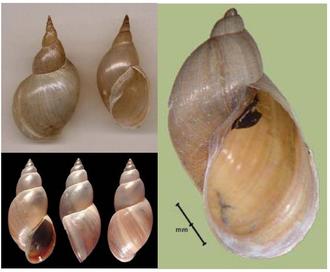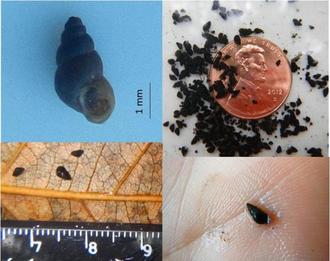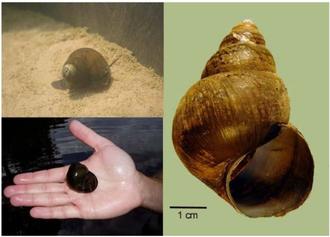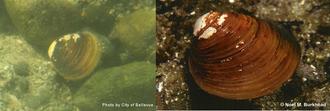
Native Species
Physids
Key identifying features
- Hold shell opening facing you with whorl pointing up, the shell opening should be on your left (i.e., left-handed shell).
- Small, ranging from 2 to 8 mm in size
- Conical in shape
- Dark brown to green in color
Text and photo reference:
Johnson P. Quick and dirty guide to pond snails. Ecology and Evolutionary Biology, University of Colorado Boulder.
Lymnaeids
Key identifying features
- Hold shell opening facing you with whorl pointing up, the shell opening should be on your right (i.e., right-handed shell).
- Common in pond habitats.
- Generally pale-yellowish to dark brown in color.
- Spiraled or conical in shape.
- Can be greater than 30 mm in size.
Text and photo references:
Johnson P. Quick and dirty guide to pond snails. Ecology and Evolutionary Biology, University of Colorado Boulder.
Invasive Species
New Zealand Mud Snail Potamopyrgus antipodarum
Key identifying features
- Hold shell opening facing out with whorl pointing up, the shell opening should be on your right (i.e., right-handed shell)
- Adult snails are often over 3-5 mm in length in Western U.S.
- Operculum (trap door) present
- Usually 5-6 whorls
- Color varies from gray, light to dark brown
- Can be found in the water or on the banks
Chinese Mystery Snail Bellamya chinensis
Key identifying features
- Hold shell opening facing you with whorl pointing up, the shell opening should be on your right (i.e., right-handed shell).
- Adult snails are often over 5-cm in length, but can be smaller.
- Operculum (trap door) present.
- Typically light to dark olive green.
- Top of whorl of shell may show chipping or weathering.
- Uniform coloring on the shell.
For more information: USGS Chinese Mystery Snail Fact Sheet
Invasive Clams
Asian Clam Corbicula fluminea
Key identifying features
- Clam size is 1 to 1.5 inches
- Colors range from yellow-green to light brown or dark olive green to black.
- Shell has concentric rings with weathering or chipping at tip.
Text and photo reference:
Foster, A.M., P. Fuller, A. Benson, S. Constant, D. Raikow, J. Larson, and A. Fusaro. 2012. Corbicula fluminea. USGS Nonindigenous Aquatic Species Database, Gainesville, FL.
